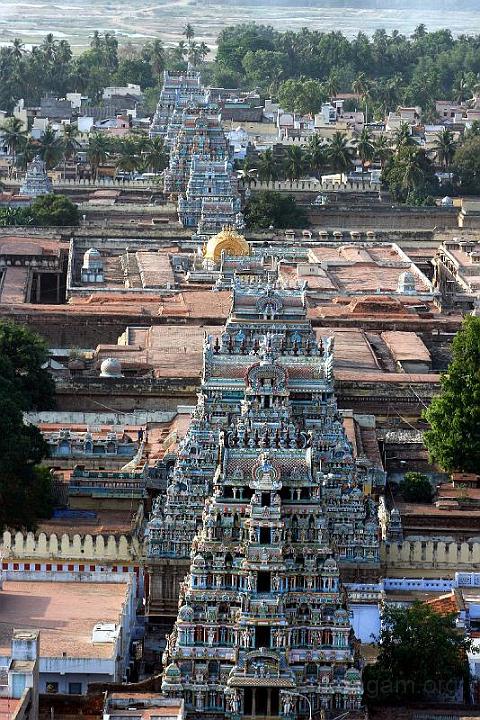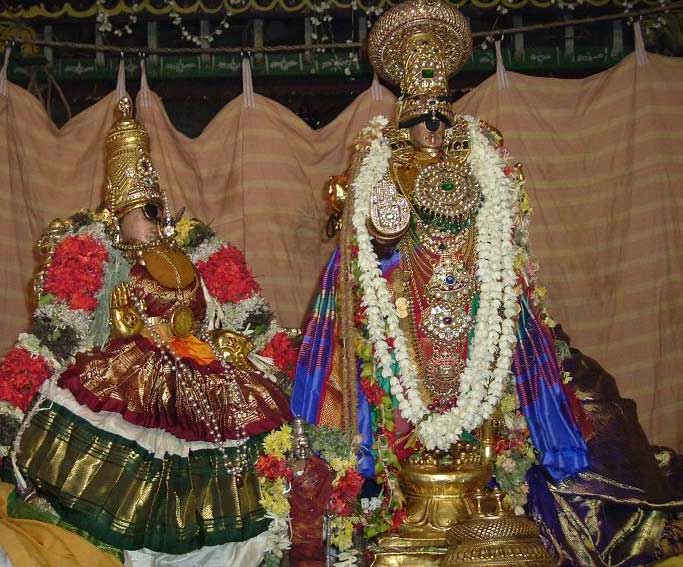Like all architecture and town planning efforts, Srirangam too embodies the worldview of the society it is located in. But what makes Srirangam unique and important to an urban historian and others is the grandness of the vision and the rigour with which Srivaishnava ideology and practice were put in the making of the settlement. All Vaishnava temples claim to be Vaikuntha and abode of Vishnu on earth. One cannot dispute these philosophical claims, but in physical form, historical importance, material and religious practices none equals Srirangam. Temple-centered settlement pattern came into practice mostly from the post-Sangam period.
Literary descriptions of the Sangam settlements especially, those of the large urban centers describe the presence of many temples in the settlement but none of them occupied the physical center. Many scholars find two reasons for the growth of temple-centered settlements in South India. One is the expansion of agriculture and the other and more important reason is the shift in importance of the temple. The bakti literature clearly portrays devotion and God as the anchor elements of the society. The growth of temples as important social and cultural institutions led to the emergence of large temple-centered settlements. Temples began to occupy the physical center of the settlement – a center that was hitherto occupied by a palace. The etymological shift in the Tamil word ‘koyil’ which earlier meant a palace but later referred only to a temple would illustrate this. Temples were laid in concentric form and the settlements too grew in concentric layers. Madurai and Chidambaram are classic examples. Srirangam on the other hand is a settlement within a temple, than a settlement around a temple. The eight enclosures well defined by huge prakara walls, punctuated by gopurams and centered around the reclining form of Vishnu has a distinctive temple appearance. The inner five enclosures make the temple and the outer three function as a settlement.
As the Lord of the temporal world, Ranganatha was considered as the Chakravartin. The town layout duly followed the silpa prescriptions of a seven enclosure palace befitting a Chakravartin.
The island formation of srirangam created a profound impression in the minds of Srivaishnavas and established a spontaneous association with the imagery of vaikuntha. The complex symbolism of Sayana Vishnu and the perception of Srirangam as Vaikuntha led to the choice of ‘sapta prakaras’. The entire landscape was perceived as sacred and Srivaishnava microcosm was built. ‘SaPta Prakara’ was the synecdoche representing the cosmos and Vishnu’s central place in it. As the Lord of the temporal world, Ranganatha was considered as the Chakravartin. The town layout duly followed the silpa prescriptions of a seven enclosure palace befitting a Chakravartin. The role of Paramesvara Samhita in the formation of Srirangam is discussed elsewhere. Srirangam has eight enclosures but function as a seven prakara temple. The outermost enclosure known as Adaiavalainjan is not a prakara. It takes a functional name – an encircling space. If we go by the references in Idu, Adaiavalainjan, at least till fourteenth century, was an open space. It was used as a refuge and for temporary inhabitation during floods. Even till date there are hardly any rituals or festivals conducted in this space. Dating the enclosures will always be mired in debates. There are also differences between the Koyil Olugu, inscriptions and traditional texts vis-a-vis prakara names. However, the upper limit for the ‘sapta prakaras’ could be fixed to 12th /13th century. This view might differ from the popular idea that the seventh and eighth enclosures were raised only in the 16th century.


Unlike other temple centers, Srirangam was not cosmopolitan but functioned as an exclusive Srivaishnava centre. The Srivaishnava Acharyas played an important role in this and probably even ensured that the developments within the town conformed to its original concept and purpose – to serve as a Srivaishanava microcosm. Landscape too played a crucial role. It delineated Srirangam as a Srivaishnava center and helped it to sustain its exclusivity. Even land transactions were at times limited to Srivaishnavas. Kanchipuram on the other hand was always a cosmopolitan center and a royal capital. So was Kumbakonam. However the settlement seems to have had difficulties in gaining political acceptance as an exclusive temple centre. While Chidambaram, Mannargudi and a few more temple centers were more temple centers were conferred thaniyoor (independent) status, Srirangam never seems to have had that privilege. Its geographical location as a borderland between many kingdoms could be one of the reasons – Srirangam also had a troubled existence with Thiruvanaikkaval, its neighbor. The vestiges of fort wall that separated the two settlements can be still found scattered in the fields. The colonial administration established in Tiruchirapalli in 180 1 took over as many as two hundred and ninety two villages owned by the temple and cut down on ‘productive’. T h e Srirangam Municipality formed in 1925 was concerned about hygiene and developed t he conservancy lanes within the ‘sapta prakaras’. The open spaces outside the prakaras were developed at this time and a new colony named ‘George Coronation Square’ was planned. In the post- Independence period, Srirangam developed as a suburb of Tiruchirapalli and lost it identity as a sacred island. The development plans have since shifted the focus outside the temple precinct and overlook the environment of this fragile island. Though recent Government orders prevent high-rise buildings within the seven prakaras, they in no way restrict the environmental degradation of the island and the demolition of historically and religiously important buildings in srirangam.
Every one of the seven enclosures except the Kizhchittirai Veethi sports the footsteps of the Periya Perumal.
Tradition declares that the seven enclosures of the temple represent the seven worlds that are known by the following names:
Bhuloka – Madaveethi
Bhuvarloka – Trivikrama Chola enclosure
Suvarloka – Akalankaveethi or Kili Chola enclosure
Maharloka – Tirumangai Mannan enclosure
Janoloka – Kulasekara enclosure
Tapoloka – Rajamahendra enclosure
Satyaloka – (near the Garbhagrham) Dharmavarma Chola enclosure.There is one more enclosure that surrounds all the seven enclosures.
This is called the ‘Adaiyavalainjan‘ enclosure.
Source:
SrI Nrisimha Priya









A Beautiful and educative write up about Srirangam
Koorainadu Urupattoor Nallaan Chakravarthi Sarangan Sridharan